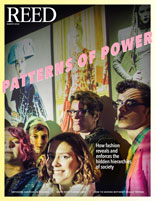
IRIS login | Reed College home Volume 95, No. 1: March 2016
Eliot Circular
Zeroing In on the Plane of Existence

Photo by Daniel Cronin
By Randall S. Barton

The Zero is assembled into a three-dimensional sculpture before being moved to a site for ritual burning. Photo by Evan La Londe
It’s an airplane. It’s a sculpture. It’s a puzzle.
It’s a work of art.
The monumental Zero Project occupied Reed’s Douglas F. Cooley Memorial Gallery in December and January, transforming the gallery into a surreal “hangar” and turning students into crewmembers who took a hands-on role in constructing the project, painstakingly stitching more than 25,000 individual photographs into a single gargantuan image.
Eschewing mimesis for collaborative assembly, Zero Project is the brainchild of artist Katsushige Nakahashi. As a boy, he played with a plastic scale model of the aircraft flown by Imperial Japanese Navy kamikaze pilots during WWII—the Mitsubishi A6M Zero warplane.
“After assembling the model I would run with it, imagining that I was the pilot,” he says. “In the course of playing with it, the plastic airplane would slowly break apart and in the end I burned it, because in reality most of the Zero airplanes actually burned. I could imagine the airplane falling to the ground and bursting into flames.”
Zero Project was initially a response to his experience of Japanese denial about the country’s actions in World War II. But the project is also about trauma and sacrifice in general, he says, serving as a vehicle for communal memory.
To make his sculpture, Nakahashi used a micro lens to take thousands of photographs of a scale model of a Zero. Joining the color enlargements with tape, he was able to fashion the two-dimensional prints into a three-dimensional sculpture, supported only by its surface.
Beginning in 1999, Nakahashi constructed a total of 19 Zero sculptures in Japan, the United States, and Australia. In 2009, he retired as the maker of the sculpture but transformed the work into a set of photos with instructions with the intention that the collective activity of making the Zero would inspire cooperation and reflection.
As a sculpture, Zero Project is neither precious nor permanent. At the close of each project, the Zero must be carried to a destruction site and burned. Nakahashi describes the ritual burning of the plane as a “return to zero.”
“While war is obviously a big theme in the project, I also like to think about how to bring peace,” Nakahashi said when he visited the gallery in January. “By building these airplanes with the people who used to be the enemy, there’s a communication that goes beyond language. There is a shared sense of pleasure in the building, which involves patience. After it’s exhibited and burned, those involved share the experience of losing it. The work is completed only at the point when it is reduced to ashes, but when the ashes are taken up by the wind, and the scorched grass begins to regrow, these processes are also all part of the artwork.”
Zero Project was part of a gift to Reed from the collection of Peter Norton ’65, and part of a group of donations to college art museums across the country with a focus on supporting programs that highlight education, creative museum practice, and the use of contemporary art to engage diverse audiences.

LATEST COMMENTS
steve-jobs-1976 I knew Steve Jobs when he was on the second floor of Quincy. (Fall...
Utnapishtim - 2 weeks ago
Prof. Mason Drukman [political science 1964–70] This is gold, pure gold. God bless, Prof. Drukman.
puredog - 1 month ago
virginia-davis-1965 Such a good friend & compatriot in the day of Satyricon...
czarchasm - 4 months ago
John Peara Baba 1990 John died of a broken heart from losing his mom and then his...
kodachrome - 7 months ago
Carol Sawyer 1962 Who wrote this obit? I'm writing something about Carol Sawyer...
MsLaurie Pepper - 8 months ago
William W. Wissman MAT 1969 ...and THREE sisters. Sabra, the oldest, Mary, the middle, and...
riclf - 10 months ago